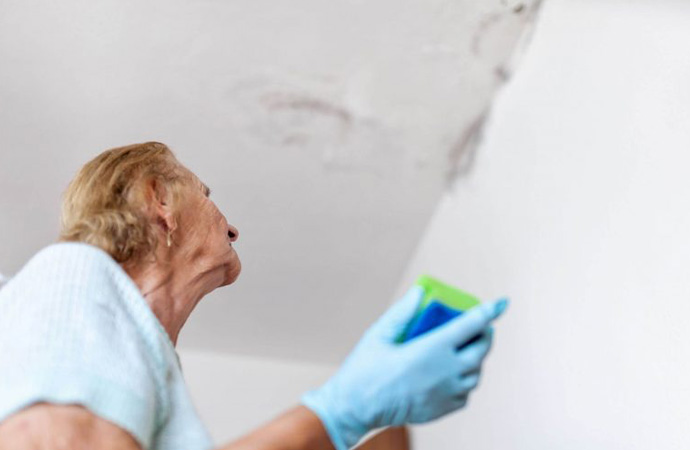Water Damage in the Ceiling From a Leak
Nearly 10% of water loss from plumbed homes in America is because of leaks. Let that sink in. That is an enormous amount of of water that just disappears each year due to a small leak hiding in your home somewhere.
If you are fortunate, the leak might be found from a dripping faucet or shower head where the water can collect and go right down the drain pipe without causing any damage in your home. However, if you are not so fortunate, the leak might be hidden inside the hollow of a wall. Even little leaks can eventually cause a large amount of water damage.
This is particularly true if you discover discoloration or water dripping down from your ceiling. Actually, leaks that cause water damage in ceilings is one of the most search terms in our area. So if you are dealing with a leak from your ceiling, you are not alone.

Know the Signs of Leaks
Leaks affecting your ceiling are pretty distinguishable. If you see your paint begin to bubble or peel, or a discoloration on your ceiling, it’s a straightforward indication that you have a moisture problem. The real problem could be that it’s not just isolated to that area of your ceiling. Because some people think it’s a minor problem, they often don’t handle it with urgency which leads to more issues and damage.
If you do see these signs, be sure to learn what you are dealing with so you can make the best decisions for taking action as you move forward.
What You Should Know
Even with distinct signs, ignoring the leak is a bad idea. Sometimes we find that is really is just a small area affected, yet other times when we have investigated further we have discovered a multitude of problems that result in a much more expensive repair. Here are some things you should be aware of:
- Homeowners insurance does not cover gradual water damage. An overflowing toilet that drips down to your first floor will generally be covered by insurance. But a stain on your ceiling that you think might be water damage and down the road you find that it was a small leak that caused the problem will generally not be covered by insurance. This is vital to understand.
- Mold can begin growing very quickly. How fast can it start to grow? Typically within 48 hours. Yet the visible clues of water damage are not always seen right away. It can take days or weeks for a small leak to show it’s signs. When you do find the signs, you must act quickly to stop the leak, and then determine how long the lead has been there. Worst case scenario, you might have a larger problem with mold clean up.
- Homeowners insurance does not cover mold remediation. It’s not just your gradual water leak damage that insurance doesn’t cover, but also mold removal. Drying out a large wet room of your home may seem like a timely and expensive job, however, mold removal is a much larger job. It’s possible that you might not be able to stay in your home during mold remediation depending on how extensive the situation is.
What To Do
The best action your can take if you find your ceiling stained or dripping water is to call a certified water damage and restoration company (Hey, that’s us!). A dependable restoration service will come to your home and give you a free assessment of the situation. By the time we are done, you should know precisely what you are dealing with. We can use an infrared imaging system to see what is wet and use our moisture meters to indicate the level of wetness so that we can provide you with an estimate for the mitigation work needed to fix your issue. If there is a leak, we can also recommend a trusted plumber that can repair the lead to that the source of the issue is rectified.








